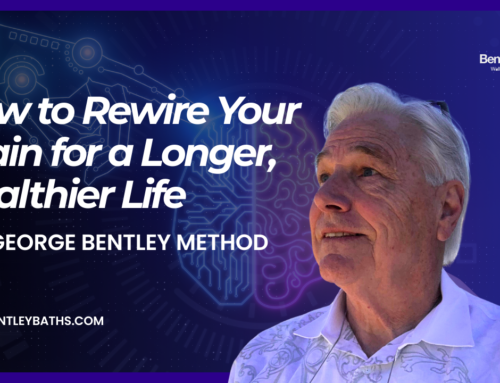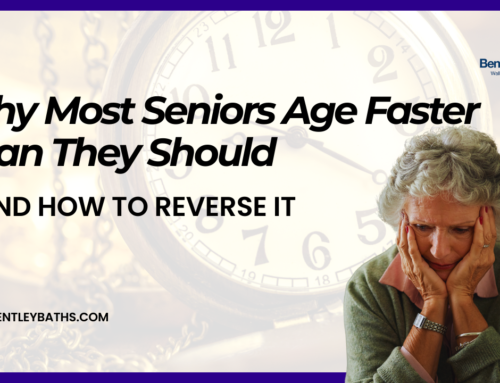If you want to watch evolution slam on the brakes, listen to a Boomer say it: “I’m fine. ”Two tiny words that have sent more seniors to emergency rooms, nursing homes, and early graves than any villain Hollywood ever dreamed up. We boomers have built careers, raised families, survived disco, and watched technology morph from rotary phones to AI. Yet when it comes to aging—our own bodies—we suddenly turn into ostriches with AARP cards, heads buried deep in the sand of denial.
The Denial Epidemic
Every year, millions of older adults are injured in falls, scalds, or preventable home accidents. The CDC reports that one out of four adults over 65 falls each year—and once you fall, your chance of falling again doubles. Those aren’t just statistics. Those are real people whose lives shrink after one bad day in the bathroom. But most of them said the same thing the week before: “I’m fine.” Denial feels noble. It feels strong. But it’s really a form of slow-motion surrender. Refusing to evolve doesn’t stop aging—it just hands the steering wheel to gravity and time.
Why We Resist Change (Even When It’s Killing Us)
Let’s be honest—none of us likes the idea of getting old. We’re the generation that invented rock ’n’ roll, space travel, and the internet. Aging feels like an insult to our creativity. So we treat safety gear, health tech, and mobility aids as symbols of weakness instead of what they are: tools for freedom. We’ve spent a lifetime upgrading everything—our cars, our phones, our homes—but we refuse to upgrade ourselves. That’s not wisdom. That’s arrogance dressed up as independence.
The Biology of Denial
Here’s the science: the human brain hates change. Once your routines feel safe, your nervous system treats anything new—like installing grab bars, getting a walk-in tub, or doing balance training—as a threat. The irony? The very thing that could save you triggers the same stress hormones as danger. So we procrastinate. We minimize. We joke. “I don’t need that yet.” “I’ll deal with it after the holidays”. “I’m not that old.” Then one slippery moment proves otherwise.
The Fall Before the Fall—and the Call Before You Fall®
Most injuries don’t start in the bathroom or on the stairs. They begin in the mind—with a story: “That happens to other people. ”The refusal to adapt to the accident. The physical fall is just the receipt. That’s why I created the phrase Call Before You Fall® twenty years ago—long before it became a tagline, it was a philosophy. It means: Don’t wait for a crisis to start caring about yourself. Pick up the phone, call for help, call your future self into action—before gravity teaches the lesson the hard way. “Call Before You Fall®” isn’t just about tubs or safety—it’s about consciousness. It’s the rallying cry for everyone ready to evolve before circumstances force them to.
Intentional Evolution Isn’t Optional
There’s a phrase I live by: “Aging is not decline—it’s design. ”Your biology is constantly updating. Cells renew. Muscles respond. Neural pathways can rewire at any age. But only if you participate. When we treat aging as something that happens to us, we become passengers. When we treat it as something we architect, we regain control. That’s the essence of Intentional Evolution—choosing to upgrade your systems (physical, emotional, environmental) before crisis forces you to. Install the grab bars before you need them. Replace the slippery tub before the hip fracture. Build strength and balance now, not after the fall. You don’t wait until the house catches fire to buy a smoke detector. Why wait until you’re in the ER to evolve?
From Resistance to Resilience
- Here’s the emotional truth: change isn’t just about safety; it’s about identity. We fear that accepting help means losing who we are. But real evolution is additive. You don’t lose yourself—you expand yourself.
- You trade the illusion of independence for the reality of autonomy. You stop pretending you’re fine and start building a life that actually is. I’ve seen clients who fought every suggestion finally take action—install a walk-in medical hydrotherapy system, start daily movement, or redesign their home for safety—and within weeks, they light up. More confidence. More energy. More joy. Not because they got younger, but because they stopped fighting reality and started shaping it. That’s Intentional Evolution in action. That’s what it means to be an Intentional Evolution Architect.
The Humor in It All
Let’s face it: there’s something absurd about our generation’s stubbornness. We’ll spend $50,000 remodeling a kitchen no one cooks in—but balk at a $10 grab bar that could save our lives. We’ll upgrade our iPhone every year but keep a 1980s bathtub that’s more dangerous than a skateboard ramp. It’s almost funny—until it isn’t. So if you catch yourself saying, “I’m fine,” try replacing it with, “I’m upgrading.” Same pride. Better outcome.
The Call to Evolve
The future belongs to those who adapt. Whether you’re 55 or 95, evolution is still available to you—right now, today. All it takes is a decision to stop living in denial and start living by design. So here’s your challenge:
1.Walk through your home as if you were auditing it for someone you love.
2.Note every risk you’d never let them ignore.
3.Then fix it for yourself. Because the truth is, evolution doesn’t wait. And neither should you.
So before you fall—literally or metaphorically—Call Before You Fall®. Your future self will thank you.









